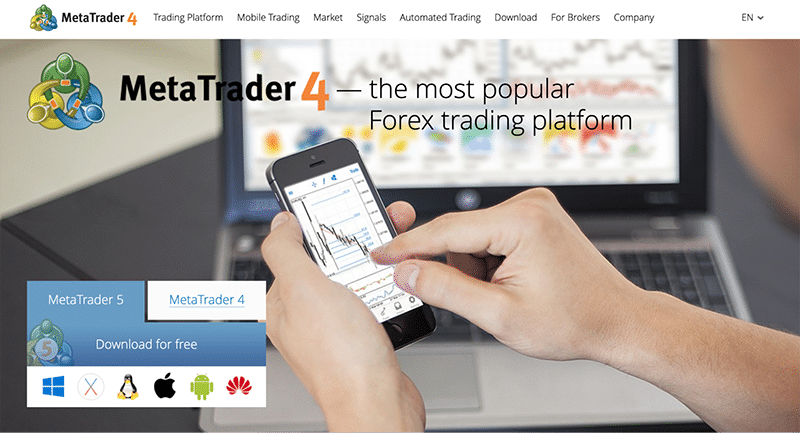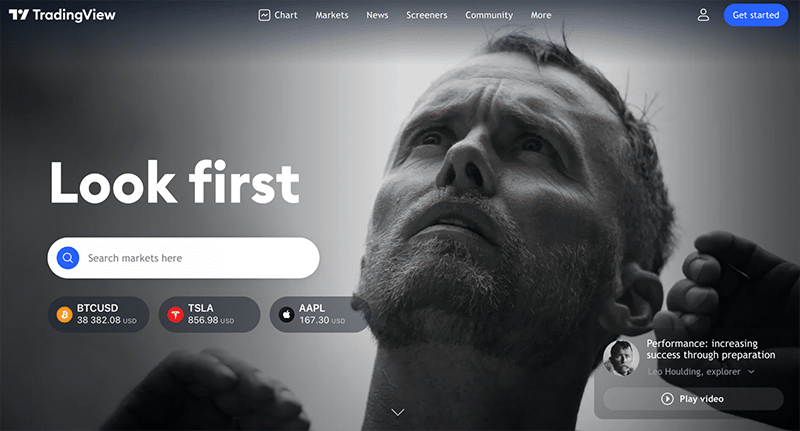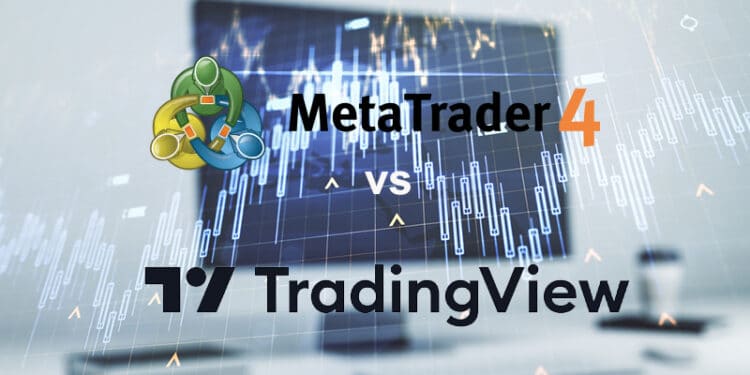If you’ve traded any financial market like forex, crypto, or indices, even for a short time, you will have undoubtedly heard of MetaTrader 4 and TradingView. These two charting platforms are some of the most popular in their niche and have existed for over ten years.
Yet, how do they compare in terms of features, usability, accessibility, and third-party integration? Let’s look at the advantages and disadvantages of each software in this article.
What is MetaTrader 4?

Forex trading and MT4 have become synonymous with one another. The platform was released in 2005 by MetaQuotes and has since become the de facto standard for currency speculation.
MT4 is supported by countless online brokers who can offer other markets like stocks, futures, indices, bonds, commodities, metals, indices, and even crypto through this platform.
MetaTrader 4 is known for its user-friendliness and capabilities in creating ‘trading robots’ and custom indicators. Best of all, the software is free to use and is available in various desktop, mobile, and web versions.
What is TradingView?

With over 40 000 publishers and over 30 million active users, TradingView has established itself as the place ‘where the world charts, chats and trades markets.’
Established in September 2011 as a New York-based financial technology brand, TradingView is a supercharged charting platform and social network for forex, cryptocurrencies, equities, commodities, indices, futures, and other unique CFDs.
It was founded by Constantin Ivanov, Stan Bokov, and Denis Globa. TradingView is largely browser and mobile-based but is now available on Windows, Mac, and Linux. Tens of crypto, futures, stock exchanges, and forex and indices brokers are connected for live and demo trading through this software.
Costs and fees
The one significant benefit of MT4 is that there are no platform-related costs. The software’s full suite of features is offered free of charge. On the other hand, although TradingView is also free to use initially, this comes with pop-up ads.
Moreover, there are many features you cannot access without a paid subscription. Plans range from $12.95 p/m (or about $130 yearly) to $59.95 (or about $479 yearly).
Fortunately, discounts from TradingView and affiliated sources are regularly provided where you can save up to 40% yearly.
In most cases, Pro (the cheapest plan) is sufficient for most traders and might be a worthy investment for the serious chartist due to how advanced this software is compared to MT4.
With a paid plan, you get access to things like the bar replay function, extensive historical data, more time-frames, server-side alerts, and loads more.
Of course, trading-related fees such as spreads/commissions for both platforms vary widely depending on the connected broker and traded instrument.
Trading automation and backtesting with TradingView vs. NinjaTrader
Unfortunately, TradingView currently doesn’t support automated trading. On the other hand, MT4 is one of the pioneers with its proprietary MQL4 (MetaQuotes Language 4) language used for developing ‘robots,’ along with unique indicators, scripts, and function libraries.
MT4 has an expansive and thriving community where one can discover a seemingly infinite number of automated strategies, codebases, articles, and more. This quality is one of the factors contributing to the platform’s immense popularity over the years.
The closest to automation that TradingView gets to is with its Pine Script language used for custom indicators and scripts. Therefore, MT4 is preferable overall when it comes to trading automation.
However, for manual backtesting, TradingView is a better place because it has the market replay function where you can play back any past moment in a market and visualize it in real-time (this functionality is only available on a paid plan, though).
This feature is not available on MT4, meaning that backtesting is a lot more time-consuming here.
Advantages of MetaTrader 4 over TradingView
Below are the areas where MetaTrader 4 beats TradingView.
- Wider forex broker access: MT4 has historically been the go-to platform for trading currencies. Nine out of ten brokers offering forex will provide their accounts through this platform. Conversely, only a handful of firms do the same with TradingView.
- No platform-related costs: As outlined in an earlier section, MT4 is free to use. However, it suffers dramatically compared to TradingView when it comes to features.
- Supports automated trading: Unlike TradingView, MT4 is home to one of the most engaging communities for automated trading.
- More beginner-friendly: The stripped-down components of MT4 make it less daunting for new traders to analyze the markets.
Advantages of TradingView vs. MetaTrader 4
Below are the areas where TradingView beats MT4.
- Much better features: In this regard, TradingView is far superior to MT4 and most other platforms, i.e., more indicators, time frames, chart layouts, etc. Firstly, TradingView’s interface is smoother, more responsive, and sophisticated primarily as it’s a browser-based application.
Another significant advantage is that charting data is automatically saved, which doesn’t occur with MT4. You don’t need to back up templates in fear of losing them with TradingView as you would with the latter.
- More expansive broker integration: Dozens of exchanges and brokers in forex, crypto, stocks, indices and futures are connected to TradingView. This means that you can follow a wide range of markets simultaneously on one platform.
With MT4, you are limited to only those provided by your connected broker.
- Easier accessibility: While TradingView is now available in the desktop version, most traders still access the software via browser. This is much simpler than downloading and installing a program, unlike MT4.
Also, you don’t need to open a demo account with TradingView to follow the markets or perform charting.
Summary
Overall, TradingView shines in interface design, advanced charting capabilities, and support of numerous instruments and brokers.
However, it’s a platform more suitable for experienced traders who follow many markets simultaneously, use special analytical features, and can afford a paid subscription.
On the other hand, MT4 is best for people who primarily trade currencies because of the sheer number of brokers supporting this platform. Furthermore, MT4 is more beginner-friendly due to its simpler, Windows XP-esque interface and is free of charge.
Also, if you are interested in automated trading, then MT4 is the way to go. However, MT4 severely lacks modernity, making it less appealing to the newer generation of traders.
Alternatively, many traders use MT4 only for executing their live positions (because it’s much more straightforward with this program) while analyzing the markets on TradingView. Therefore, you get the best of both worlds.
Overall, even if you only trade currencies, TradingView is worth the money and offers an enjoyable, engaging, and aesthetic trading experience matched only by a few.




